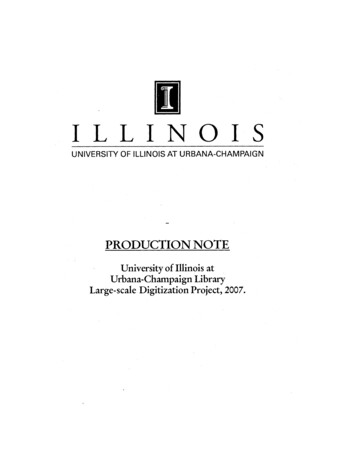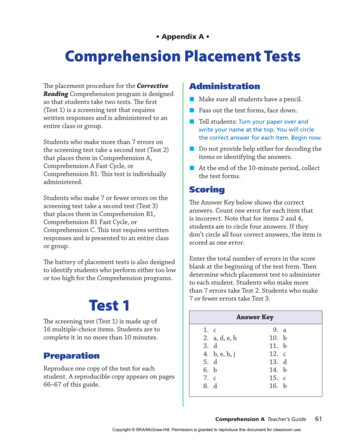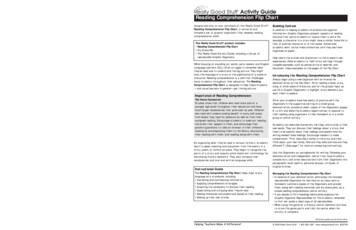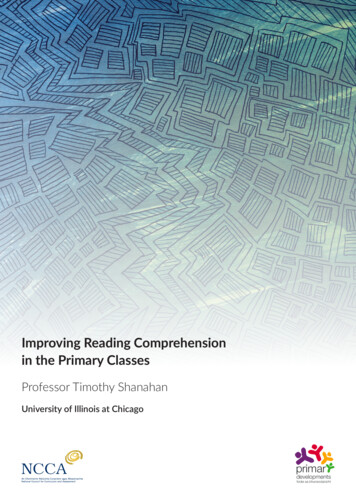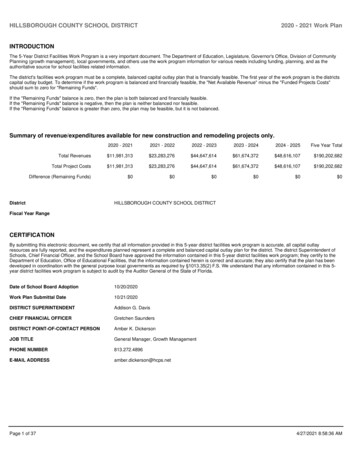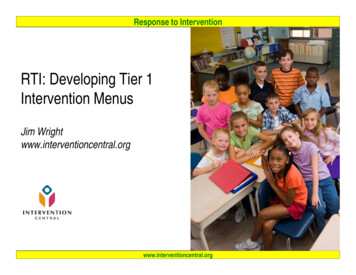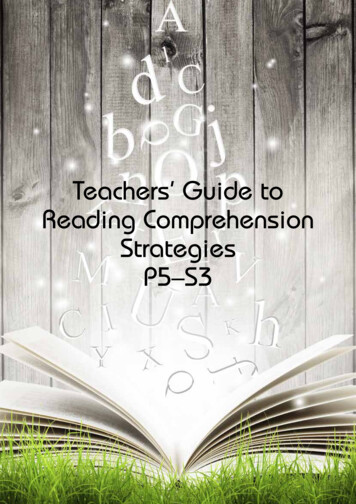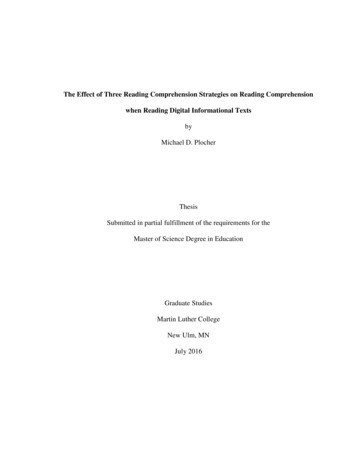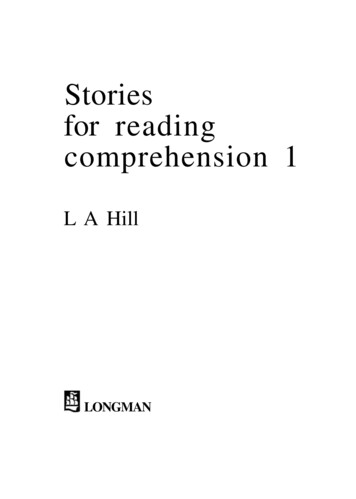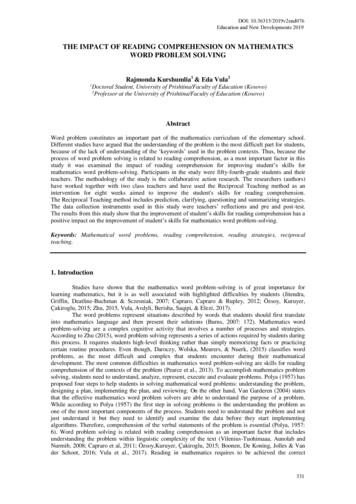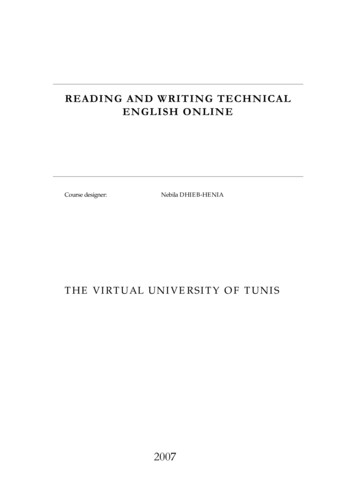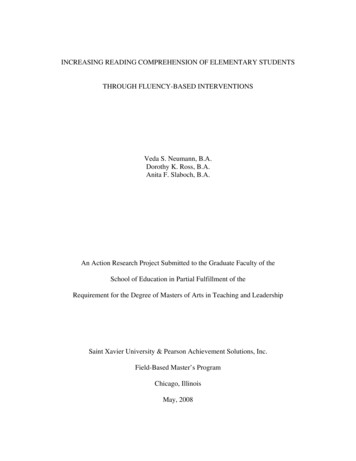
Transcription
INCREASING READING COMPREHENSION OF ELEMENTARY STUDENTSTHROUGH FLUENCY-BASED INTERVENTIONSVeda S. Neumann, B.A.Dorothy K. Ross, B.A.Anita F. Slaboch, B.A.An Action Research Project Submitted to the Graduate Faculty of theSchool of Education in Partial Fulfillment of theRequirement for the Degree of Masters of Arts in Teaching and LeadershipSaint Xavier University & Pearson Achievement Solutions, Inc.Field-Based Master’s ProgramChicago, IllinoisMay, 2008
iTABLE OF CONTENTSABSTRACT . . .iiiCHAPTER 1: PROBLEM STATEMENT AND CONTEXT . .1General Statement of the Problem . . .1Immediate Context of the Problem . . .1Local Context of the Problem .15National Context of the Problem . .19CHAPTER 2: PROBLEM DOCUMENTATION . .20Evidence of the Problem . .20Probable Causes .27CHAPTER 3: THE SOLUTION STRATEGY .37Review of the Literature .37Project Objective and Processing Statements .43Project Action Plan . .43Methods of Assessment .44CHAPTER 4: PROJECT RESULTS . .47Historical Description of the Intervention . .47Presentation and Analysis of Results .53Conclusions and Recommendations . .63REFERENCES . . .67APPENDICES . .77Appendix A: Student Survey .77Appendix B: DIBELS . .78
iiAppendix C: Choose-A-Title . . .79Appendix D: Paired Reading .80Appendix E: Echo Reading 81Appendix F: Choral Reading .82Appendix G: Poetry Reading .83Appendix H: Reader’s Theater . .84
iiiABSTRACTThe authors of this action research project report implemented oral reading fluency-basedinterventions for the purpose of improving students’ reading comprehension. Six students ingrade three, six students in grade five and six students in grade six participated in the study fromMonday, August 27 through Friday, December 7, 2007.Researchers observed that in the targeted reading groups, deficiencies in any element of oralreading fluency were associated with reading comprehension problems. The teacher researchersused the following tools to document evidence; Dynamic Indicators of Basic Early LiteracySkills (DIBELS) Oral Reading Fluency (ORF), which indicated that 50% of students at Site Aand 83% of students at Site B were below benchmark score for oral reading fluency. Thecomprehension based assessment (Choose-A-Title) resulted in 61% of the students choosing theincorrect title. As a result of the student survey, it indicated that 17% of the students responded“almost never” when asked “I think others like my reading”. Students’ struggles with accuracy,rate, and prosody revealed deficiencies that inhibited the processing of meaning.The interventions implemented were three 20-minute weekly sessions consisting of one sessionof reader’s theater activities including choral reading, echo reading, and poetry, and two sessionsof partner reading during which student pairs engaged in repeated oral reading and reading alongsilently while listening as oral reading was modeled. Teachers are encouraged to model fluentreading illustrating proper rate and accuracy. Reading and rereading exercises such as readingwith a model reader, choral reading, reader’s theater, and partner reading can improve fluency(Vaughn & Linan-Thompson, 2004).As a result of the interventions, students demonstrated increased awareness of the three elementsof oral reading fluency: accuracy, rate, and prosody. Students practiced self-monitoring theseelements while participating in paired reading and cooperative learning groups. The post datarevealed that there was a decrease in students’ positive responses to “I read with expression andfeeling”. Thirty-three percent of students responded “almost always” on pre documentation and28% on post documentation. The “usually” category declined from 50% to 44%. Studentsresponded best to interventions that involved repeated reading in the form of rehearsal followedby performance, such as choral poetry reading and reader’s theater. Students demonstratedengagement in the activities while becoming more realistic in self-evaluation
1CHAPTER 1PROBLEM STATEMENT AND CONTEXTGeneral Statement of the ProblemThe purpose of this action research project was to improve reading comprehensionthrough oral reading fluency. Students’ problems with reading comprehension are revealedthrough difficulty with one or more of the three elements of oral reading fluency: automaticity,accuracy, and prosody. Fluency rates were determined through DIBELS Oral Reading Fluencyassessment. Comprehension was assessed by requiring students to identify the main idea of agrade-level passage. Students reported their attitudes about oral reading by responding to a sixquestion survey.Immediate Context of the ProblemSite ASite A is a parochial elementary school established in 1957 located in a northwest suburbof a major city. This parish was established in October of 1955. At that time, the pastorenvisioned the creation of a “fully functioning faith community” encompassing the church, aconvent, a rectory, and school. The parish school opened its doors for classes in September of1957 for grades 1-6. As the school population increased to about 1,000 students, construction ofthree additions were underway including eight classrooms, two balcony classrooms, and a juniorhigh wing. Today, the day school services over 500 students and includes preschool,kindergarten, and grades 1-8. Grades 1-4 are self-contained instructional classrooms and grades
25-8 are departmentalized. An extended-day after school program is also available. The facultyconsists of 41 teachers and includes full-time instructors of library, physical education,computer, art, and music. The school has co-curricular coordinators or directors including anathletic director, band coordinator, and choral coordinator. Co-curricular programs includeforeign language, student council, student newspaper, student yearbook and service outreachgroups (Site A school website, 2007).The school’s total student body includes a population of 507. Of these 507 students, 252(50%) are males and 255 (50%) are females. The graduation rate at Site A is consistent at 100%yearly. The students display an average-daily attendance rate of 96%, with a mobility rate of 8%transferring out and 16% transferring in, and a truancy rate of 0%. The predominate ethnicrepresentation is caucasian. The ethnicity breakdown is shown in Table 1 (Site A school report,2006).Table 1Ethnicity at Site A (n iveMultiracial American%31805120n13340724591The school’s teaching staff consists of 28 full-time teachers. Of the full-time teachers, 2(7%) are males and 26 (93%) are females. There is a total of three teacher aides working at Site
3A. Of these three aides, one (33%) is working full time, and two (66%) are working part time.All of the teaching staff are Caucasian. The percent of teachers with masters degrees isapproximately 22% (n 28). The average years of employment is at six years. There is a 19.5:1student to teacher ratio and the teachers have a 97% average-daily attendance rate (Site A schoolreport, 2007).Daily instruction involves all core subjects including religious education, language arts,mathmatics, science, and social studies. In the curriculum the greatest emphasis is inCommunication Arts across grade levels. The breakdown of instructional minutes is shown inTable 2 (Site A handbook, 1997).Table 2Breakdown of Instructional MinutesCurriculum AreaPrimary LevelIntermediate LevelUpper LevelReligious ation ematics200200225Science100200225Social Studies100200225Students in grades 3, 5, and 7 take the Terra Nova Multiple Assessment AchievementTests as mandated by the Archdiocese of Chicago. This test differs from the California
4Achievement Test or the Iowa Test of Basic Skills because 20% of the test students are requiredto provide a written response as opposed to a multiple choice option (Site A home report, 2006).The Terra Nova scores indicate that Site A’s students score at or above the nationalnorms in all subjects and at all grade levels. Terra Nova Achievement test results based onnational percentiles for 2005/2006 years are shown in Table 3 (Site A home report, 2006).Table 3Terra Nova Achievement test Results Based on National Percentiles. 2005/2006 ComparisonGrade 3Grade 5Grade 0/7865/8071/77Social Study67/6875/8185/80School personnel includes a principal, an assistant principal, 28 full-time teachers (PK-8), 3teachers aides (PK), 2 librarians, 3 secretaries/clerks, and 3 janitors and or maintenance workers.There are a total of 100 volunteers. Of these volunteers, 20 (20%) work on a regular basis, 70(70%) work periodically, and 10 (10%) work with Pre-K only. There is no registered nurse onthe staff (Site A school report, 2006).Site A is affiliated with the Catholic Church and has many programs available which help
5to serve the school community. Programs like Rainbows for all God’s Children and Kids WhoCare, assist those who are in need in the school community and beyond. Rainbows for all God’sChildren is a year-long discussion for students of have experienced a loss through either death ordivorce. Fourth through eighth grade students participate in service learning projects, coordinatethe Saint Angela’s Christmas party, as well as, the Christmas bazaar. In addition, each year atheatrical production, Summer Stock, is performed by 5th through 8th grade students. The showis cast in the spring and rehearsals continue through the summer. This program introducesstudents to the elements of staging including set design and building, lighting, choreography, andacting (Site A family directory, 2006).The building complex includes the church, a rectory and gathering space, 33 classrooms,1 science lab, 1 computer lab, 2 gymnasiums, 1 faculty lounge, 1 business office, 4 meetingrooms, 1 art room, 1 music room, 1 library, a playground and another parking lot play area (SiteA school website).The school has an approved technology plan in place. The school has a local areanetwork and uses a wireless network. All administrators, teachers, and librarians have access tothe internet. Students have monitored access to the internet. Teachers and parents have access toPearson Centerpoint, which is a software program that maintains grades for students. Inaddition, a school e-mail system is utilized (Site A technology survey, 2006).
6Site BSite B is a parochial school located in a northwest suburb of a major city. The school hasbeen a vital part of the community since 1925. It attracts students from a variety of thesurrounding areas. While 63% (n 452) live within 1.5 miles of the school, 37% (n 268) livemore than 1.5 miles from the school. Of the 720 students who attend the school, 52% (n 377)are male and 48% (n 343) are female. The predominate ethnic representation is Caucasian. Theethnicity breakdown is shown in Table 4 (Site B school report, 2006).Table 4Ethnicity at Site B by Percentage (n tiracialNativeAmerican%2094310n1506772350At this time, 0% of the students are English Language Learners (ELL), even though 1%(7) of Site B’s students was born outside of the United States. As there is no food serviceprogram, 0% of the students receive free lunches and 0% receives reduced lunches. Ascholarship fund provides full tuition assistance for 1% (5) of the students and partial tuitionassistance for 1% (4) of Site B’s students. The average student daily attendance rate is 99% (SiteB school report, 2006).
7Of the 37 teachers at Site B, 100% are Caucasian and 100% are female, 41% (15) have amasters degree and 100% have a bachelors degree. The average teacher’s salary is 34,000.00and the mean year of employment is nine. There is a 17/1 student to teacher ratio and theteachers have a 95% average daily attendance rate (Site B school report, 2006).Site B is a traditional 9/10 month school year with preschool, prekindergarten, andkindergarten self contained and 1st through 8th departmental. Programs are offered in art,library, physical education, computer, and LD/Remedial. Co-curricular programs are offered inathletics, band, chorus, foreign language, student council, school newspaper, school yearbook,and Rainbows. Site B offers a before school and extended day program for prekindergartenthrough 8th grade. In 2003 Site B received certificates from the Illinois State Board and TheOffice of Catholic Education (Site B school brochure, 1998). Site B’s institutional developmentplan includes a school improvement plan, long range planning, and endowment fund (Site Bschool report, 2006). In the curriculum the greatest emphasis is in Communication Arts acrossgrade levels. The breakdown of instructional minutes is described in Table 5 (Site B handbook,1997).
8Table 5Weekly Instructional MinutesCurriculum AreaPrimary LevelIntermediate LevelUpper LevelReligious ation Arts850650550Health ence100200225Social Studies100200225The Terra Nova scores in Table 6 indicate that Site B’s students score at or above thenational norms in all subjects and at all grade levels. Although all students of the Archdiocesetake the same test each year, schools do not receive results with comparisons to other parochialschools. Since local public schools do not take the same test, comparisons with schools districtsare not possible (Site B home report, 2006).
9Table 6Terra Nova Achievement Test Results Based on National Percentiles 2005/2006 ComparisonGrade 3Grade 4Grade 5Grade 6Grade 7Number Taking 976/8885/83Total 181/84Social Studies7982/8990/8981/8388/89Site B’s administrative staff consists of a principal and an assistant principal. There aresix teacher aides employed at Site B, 67% (4) of whom have earned a bachelors degree and 33%(2) having earned some college. A full time staff member is employed for art, music, physicaleducation and technology. Site B employs one librarian, one business manager, threesecretaries/clerks, and three janitors/maintenance. Site B has co-curricular programs in athletics,band, chorus, foreign language, student council, school newspaper, school yearbook, andRainbows. Additional activities that contribute to a well rounded educational experience include:sharing activities with inner city schools, scouting, art club, chess club, Battle of the Books,acolyte service, scholastic competitions, and fine arts presentations (Site B school report, 2006).The original building for Site B was built in 1925. It is still standing today and is nowconsidered the Elementary Grade Center which houses preschool through 4th grade. In the1960s, a second building was constructed across the alley from the original and it is now
10considered the Upper Grade Center and houses 5th through 8th grade. In 2002 a 7.5 milliondollar renovation was completed on both buildings which added 5 classrooms, science lab, artroom, computer lab, library, parish life center, and meeting rooms. Replacement windows, airconditioning, and updated wiring for technology were also installed (Site B school report, 2006& school brochure, 1998).Site CSite C is a K-5 public school in the same suburban community. Opened in 1950 andexpanded in 1995, Site C is one of five K-5 buildings. The Site C student enrollment of 399includes 51% (n 205) boys and 49% (n 194) girls. Ethnicity at Site C is reported in Table 7.Table 7Ethnicity at Site C by Percentage (n 399)AsianBlack American4.80.093.51.30.50.0Other information about the student population is reported in Table 8.Table 8Other Information by Percentage (n ncyMobilityAttendance1.01.30.02.395.1
11The total of 37 teachers at Site C includes 34 (91.9%) females and 3 (8.1%) males. The24 teaching assistants are female. One teacher is Asian-American, and the remainder of the SiteC teaching staff is Caucasian.There are three regular education classes of each grade level at Site C. Two kindergartenteachers provide three half-day sessions, staffing two morning classes and one afternoon class.Two additional classrooms serve kindergarten and first grade students with special physical orlearning needs. Each special needs classroom is staffed by a teacher and assistants, with a total oftwo teachers and seven assistants working in the special needs K-1 classrooms. The autismresource program is staffed by two teachers and eleven assistants, divided into one primary andone intermediate classroom. A full-time early intervention position is shared by two teachers.One half-time teacher provides pullout support in reading or math for low-achieving second andthird grade students. An instructional resource program for students identified for specialeducation services is staffed by two teachers with three assistants. A teacher who divides timebetween two schools provides enrichment in math and reading to high ability primary studentswho participate in weekly pullout groups. One teacher provides daily math and readinginstruction for gifted intermediate students.The Site C staff includes three physical education teachers, two art teachers, twomusic teachers, and a foreign language teacher who divides time between two schools. TheLearning Resource Center (LRC) is headed by a director who is also a certified teacher. Twohalf-time assistants and a full-time technologist complete the LRC staff. Additional staffmembers include two speech pathologists and two half-time social workers. A physical therapistand an occupational therapist work with the special needs population. Site C also houses aspecial education facilitator.
12The district’s average annual teacher salary is 61,257. Teachers have an average of 11.9years teaching experience. At Site C, 25 (69%) teachers hold master’s degrees and 12 (31%) areat the bachelor’s level. Districtwide, the pupil - certified staff ratio is 12 to 1. Class sizes inregular education rooms range from 16 students per kindergarten classroom to 25 fifth gradestudents per classroom.The core subjects at Site C are English / language arts, mathematics, science, andsocial science. The core subjects are taught daily, as shown in Table 9.Table 9Grades 1-5 Daily Instructional MinutesEnglish / language artsMathematicsScienceSocial Science144573030All students participate weekly in one 45-minute art class and two 30-minute musicclasses. Students in grades 1 through 5 have four 30-minute physical education classes per week.Kindergartners have three 30-minute physical education classes a week. Beginning in secondgrade, students participate in the Foreign Language in the Elementary School program.French is taught in classrooms for 30 minutes twice a week.Overall Illinois Standards Achievement Test performance at Site C in 2004-2005 was87.7%, slightly above the district level of 87.5%. Table 10 shows improvement in the percentageof ISAT scores meeting or exceeding standards in 2004-2005 compared with 2003-2004.
13Table 10Percentage of ISAT Scores Meeting or Exceeding 480.091.881.42004-200586.5100.092.0Site C’s principal has served since 1999, and will soon complete her doctorate. Theaverage annual salary of an administrator in the district is 120,313. There is no assistantprincipal at Site C, but one classroom teacher and one instructional resource teacher aredesignated to provide assistance when need arises. The office is staffed by one full-timesecretary and one half-time office assistant. A registered nurse works as the full-time healthassistant. These staff members are female. A full-time maintenance team of three men overseesthe building and grounds. The staff members listed above are Caucasian except for one noncertified member of the office staff who is Asian-American.Site C is the location of the district’s STRIVE resource rooms. The STRIVE programserves students with autism and related disorders, supporting inclusion and providing specialeducation services. Students with special needs are included in regular classroom activities asmuch as possible, and they are further integrated into the student community throughvoluntary peer-to-peer outreach programs such as the Circle of Friends model.Site C is a single story building located in a neighborhood in which most houses werebuilt after World War II. The school property is one block wide and two blocks deep. OriginallyL-shaped, the building received an addition in the mid-1990s that provided a new LRC, aseparate computer laboratory, a second gymnasium, and additional classrooms. The renovationresulted in the building’s present rectangular configuration. The four hallways surround a central
14courtyard that has been the focus of improvement projects in which teachers, students, andparents have collaborated. Over several years these teams have added features such aslandscaping and a small pond, along with paths, benches, and a picnic table.The construction project completed in 1995 included a computer laboratory toaccommodate all the students in a class, with teachers scheduling time as needed. In addition,every classroom is equipped with at least five student computers. Recently, a laptop cart thatcan be reserved for classroom use has been added to the available technology resources.There is a blacktop and an intermediate playground at the northeast end of the building.Another blacktop adjoins the primary playground at the southwest corner of the building. Theremaining land consists of a large grassy field that is used for physical education activities andextracurricular activities such as park district youth soccer practices and games.Based on examining evidence about the population demographics of the community inwhich Sites A, B, and C are located, the teacher researchers are confident that students’ readingcomprehension difficulties are not related to economic and social status. Reading instruction thatfocuses on decoding skills and lower order thinking neglects the development of readingcomprehension in the true sense of reading for meaning. In many cases, students are not taughtstrategies that build a framework for reading comprehension by engaging in higher orderthinking (Zimmerman & Hutchins, 2003).Through informal observation and DIBELS scores Site A and B teachers report that themajority of their students who struggle with comprehension perform in the low average to belowaverage range in reading ability. Their comprehension concerns can most likely be linked to poorreading foundation skills such as decoding, phonemic awareness, and fluency skills.At Site C, many students are well-prepared to acquire decoding skills. Primary teachers
15have incorporated guided reading practices into the daily reading block, using DIBELSassessments in August, January, and May to measure individual growth. Students are screenedfor weekly challenge pullout on the basis of DIBELS scores and performance on specialclassroom identification lessons incorporating reading comprehension and higher order thinking,followed by running records with a comprehension component. Students who demonstrate goodcomprehension also have high DIBELS scores. Other students with equally high DIBELS scoresdo not demonstrate good reading comprehension. Teachers at Site C find that implementingreading instruction to improve students’ reading comprehension is challenging and complex.Poor decoding skills are the cause of some students’ reading comprehension problems, but gooddecoding skills are not always associated with good comprehension.Local Context of the ProblemSite A, Site B, and Site C are all located in the same northwest suburban area. Thecommunity has a population of 37,274 people. The 2000 census listed the population as 38,114indicating the population has remained relatively stable. The median income is 82,092 and themedian age is 42. Per the census, 92% of the population graduated from high school and 46%graduated from college.There are 13,438 households and an average household size of 2.6 persons. The crimeindex suggests the risk of certain types of crime occurring in this community as compared to thenational average. The national average for each crime equals a score of 100. The total crimeindex equals 37 of which the following categories are listed; Personal (28), Murder (7), Rape(38), Robbery (11), Assault (51), Property (54), Burglary (61), Larceny (64), and MV Theft
16(27). The census listed an employment rate of 97%. The work force is considered 81% whitecollar and 19% blue collar. The types of employment are shown in Table 11.Table 11Type of Employment by on30Production/Repair7Operators/Laborers5Service Occupation8Sites A, B, and C are located in a suburb a few miles northwest of a major city.Convenient access to the city contributed to the growth of the town from its beginnings in thenineteenth century as a small farming community. In the 1870s a businessman secured a railconnection between the small town and the city. Well-maintained nineteenth century homes thatstill ring the uptown area were constructed in the years that followed, as locally grown produceand manufactured goods were sent into the city by rail and the local economy grew.Home building expanded from this central area, taking over farm land through the firstthree decades of the twentieth century. The Great Depression that began in 1929 halted growthuntil around 1950, when the post-World War II building boom pushed into undeveloped land tothe north, west, and south.Sites A and C serve neighborhoods in the south and west areas while Site B serves thecentral uptown area of postwar expansion. During the second half of the twentieth century
17Georgians, ranch styles, and split level homes lined the blocks, with a few white framefarmhouses scattered among them. In recent years, the unavailability of building lots andcontinuing demand for the area’s proximity to the city and the regional airport have driven amarket for replacing existing homes with larger ones. Most recently, the city is implementing aredevelopment plan renovating the town’s uptown area with new retail establishments andrestaurants.The city has several recreational facilities including a leisure center, a community center,an ice arena, a driving range, batting cages, a nature center, a senior center, a dog park, a skatepark, an art center, and three swimming pools.The mission statement of Site A expresses the following.Mary, Seat of Wisdom, believing that our children are our greatest resource, is committedto both excellence in education and the holistic development of the child. An integral part ofMary, Seat of Wisdom is the faith community, which actively involves itself in the fostering ofChristian values and serves as a role model of Catholicism in action. Mary, Seat of Wisdomstrives to empower its students with the knowledge, values, and skills which will enable them tobecome active participants and effective leaders in both the church and world community.”The mission statement of Site B expresses the following.St. Paul of the Cross Parish School is committed to reach out through prayer, service,and education to the needs of the community. In this supportive atmosphere, studentsare encouraged and challenged by the partnership of parents and teachers to use theirunique abilities to be lifelong, contributing Catholic Christians.
18The public elementary school district has an enrollment of 4,400 K-8 students. Themission of the district is “to enable all students to achieve their full potential as they developthe skills, knowledge, and attitudes to live successful, socially responsible lives in a changingglobal economy.” The mission statement of Site C expresses that “In partnership with thecommunity, (Site C’s) mission is to provide opportunities that challenge all children to reachtheir potential in a safe and supportive environment.” At the district level and at the buildinglevel, the slogan “Meeting the Needs of the Whole Child” reflects a philosophy of promotingsocial and emotional development along with academic growth.A superintendent oversees the district’s two 6-8 middle schools, five K-5 elementaryschools, and one early childhood special education center. Two assistant superintendents servethe district. Their responsibilities are divided, with one assistant superintendent for curriculumand instruction, and one assistant superintendent for human resources. Each middle school has aprincipal and an assistant principal. The five K-5 schools and the early childhood center areheaded by principals. The two largest K-5 buildings share one assistant principal.In 2003-2004, local property taxes provided 35,582,243 toward expenditures of 46,514,806. Despite efforts to control expenses, expenditures continued to outpace sources ofrevenue. The passage of a referendum in 2007 averted the
INCREASING READING COMPREHENSION OF ELEMENTARY STUDENTS THROUGH FLUENCY-BASED INTERVENTIONS Veda S. Neumann, B.A. Dorothy K. Ross, B.A. . Art/Drama/Music 120 120 120 Communication Arts 850 650 550 Health/Physical Education 130 130 130 Mathematics 200 200 225 .
